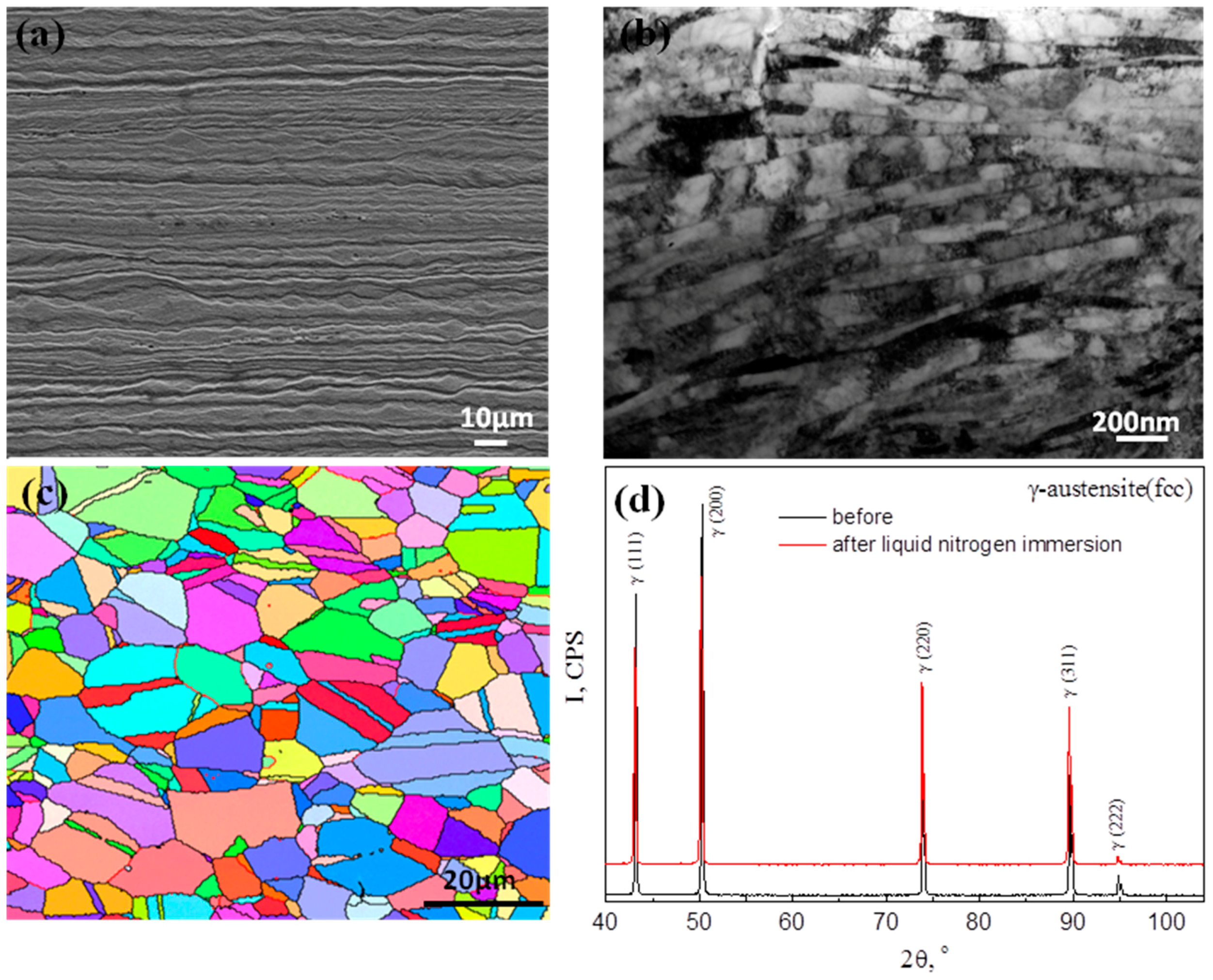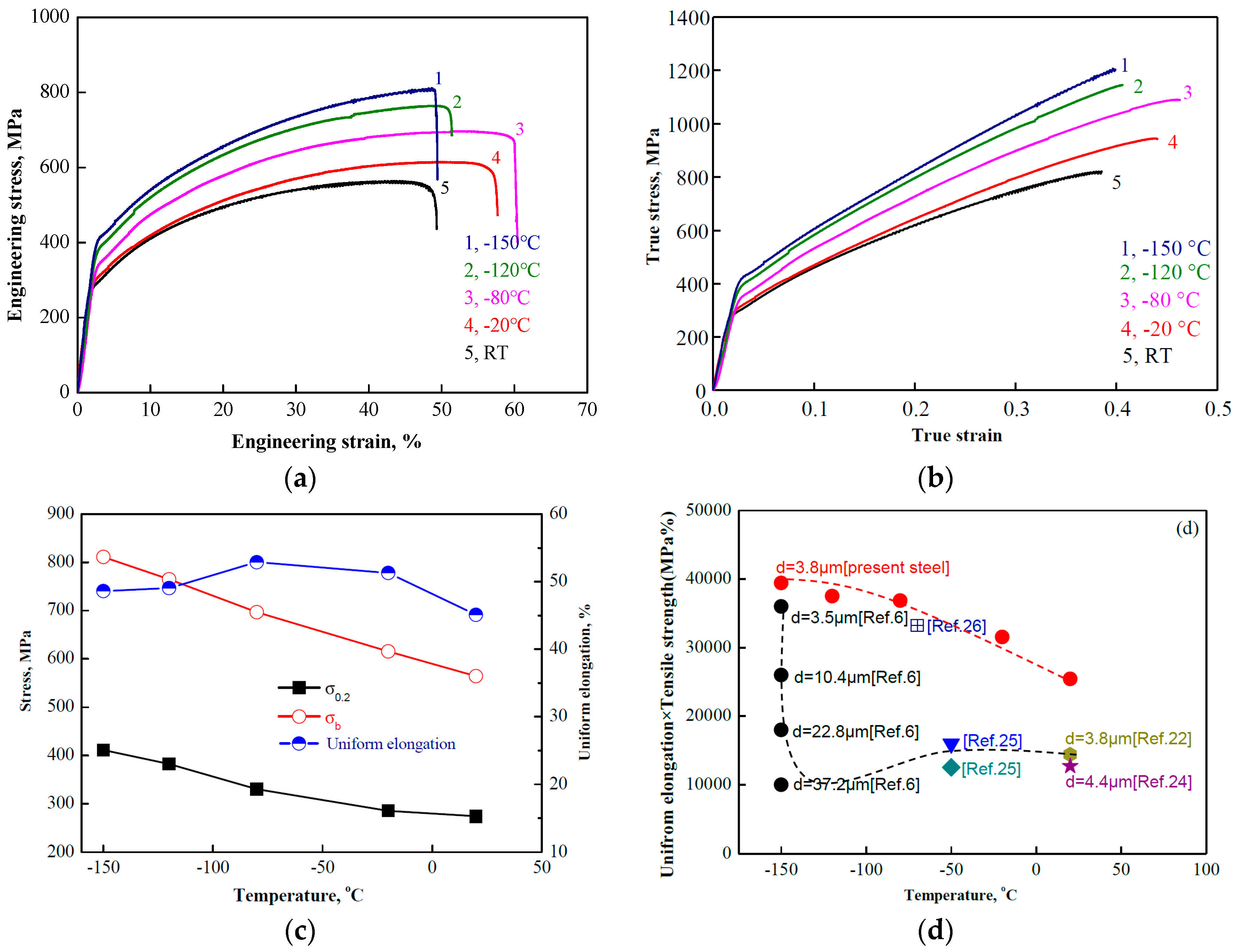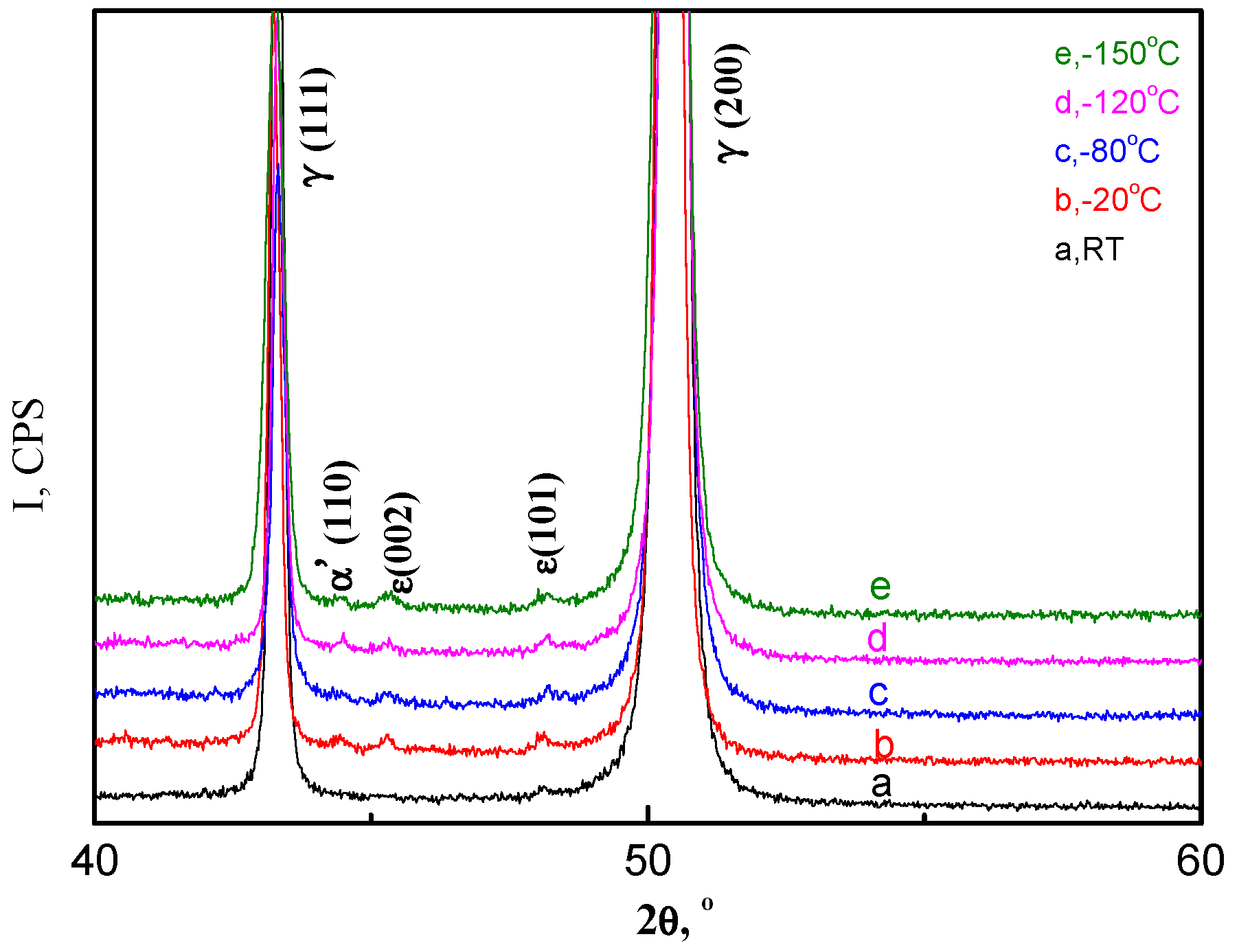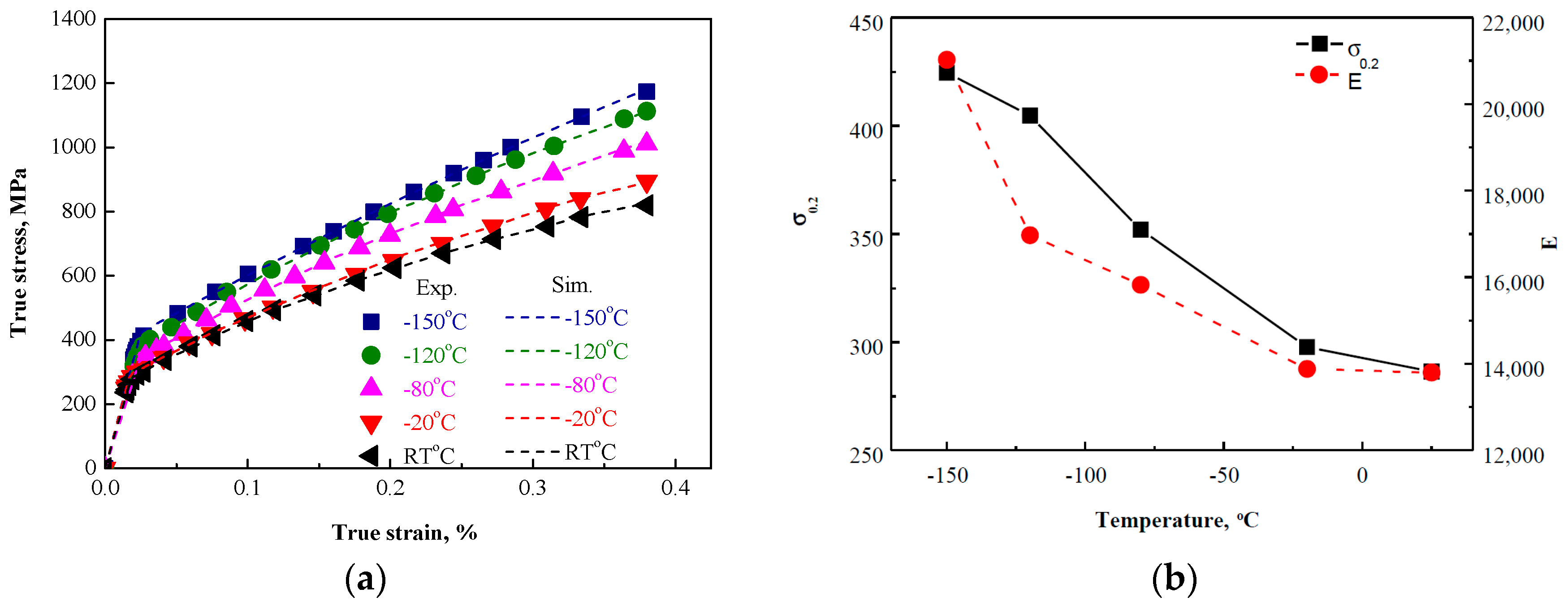A Fine Grain, High Mn Steel with Excellent Cryogenic Temperature Properties and Corresponding Constitutive Behaviour
Abstract
:1. Introduction
2. Experimental Procedure
3. Results and Discussion
3.1. Tensile Properties of Investigated Steel at Various Temperatures
3.2. Constitutive Description of Mechanical Behaviour at Various Temperatures
4. Conclusions
Acknowledgments
Author Contributions
Conflicts of Interest
References
- Lu, K. The future of metals. Science 2010, 328, 319–320. [Google Scholar] [CrossRef] [PubMed]
- Herrera, C.; Ponge, D.; Raabe, D. Design of a novel Mn-based 1 GPa duplex stainless TRIP steel with 60% ductility by a reduction of austenite stability. Acta Mater. 2011, 59, 4653–4664. [Google Scholar] [CrossRef]
- Bhadeshia, H. Twinning-induced plasticity steels. Scr. Mater. 2012, 66, 955. [Google Scholar] [CrossRef]
- Vercammen, S.; Blanpain, B.; Cooman, B.C.D.; Wollants, P. Cold rolling behaviour of an austenitic Fe-30Mn-3Al-3Si TWIP-steel: The importance of deformation twinning. Acta Mater. 2004, 52, 2005–2012. [Google Scholar] [CrossRef]
- Ying, S.; Dong, H. The third generation auto sheet steel: Theory and practice. In Proceedings of the FISITA 2012 Word Automotive Congress; Lecture Notes in Electrical Engineering. Springer: Berlin, Germany, 2013; Volume 195, pp. 933–947. [Google Scholar]
- Koyama, M.; Lee, T.; Chong, S.L.; Tsuzaki, K. Grain refinement effect on cryogenic tensile ductility in a Fe-Mn-C twinning-induced plasticity steel. Mater. Des. 2013, 49, 234–241. [Google Scholar] [CrossRef]
- Dastur, Y.N.; Leslie, W.C. Mechanism of work hardening in hadfield manganese steel. Metall. Trans. A 1981, 12, 749–759. [Google Scholar] [CrossRef]
- Tomota, Y.; Strum, M.; Morris, J.W. Microstructural dependence of Fe-high Mn tensile behavior. Metall. Trans. A 1986, 17, 537–547. [Google Scholar] [CrossRef]
- Grässel, O.; Krüger, L.; Frommeyer, G.; Meyer, L.W. High strength Fe-Mn-(Al, Si) TRIP/TWIP steels development-properties-application. Int. J. Plast. 2000, 16, 1391–1409. [Google Scholar] [CrossRef]
- Bouaziz, O.; Allain, S.; Scott, C.P.; Cugy, P.; Barbier, D. High manganese austenitic twinning induced plasticity steels: A review of the microstructure properties relationships. Curr. Opin. Solid State Mater. Sci. 2011, 15, 141–168. [Google Scholar] [CrossRef]
- Sasaki, T.; Watanabe, K.; Nohara, K.; Ono, Y.; Kondo, N.; Sato, S. Physical and mechanical properties of high manganese non-magnetic steel and its application to various products for commercial use. Trans. Iron Steel Inst. Jpn. 2006, 22, 1010–1020. [Google Scholar] [CrossRef]
- Morris, J.W., Jr.; Dalder, E.N.C. Cryogenic structural materials for superconducting magnets. JOM 1985, 37, 24–33. [Google Scholar] [CrossRef]
- Kim, Y.G.; Han, J.M.; Lee, J.S. Composition and temperature dependence of tensile properties of austenitic Fe-Mn-Al-C alloys. Mater. Sci. Eng. A 1989, 114, 51–59. [Google Scholar] [CrossRef]
- Hong, S.H.; Han, Y.S. The effects of deformation twins and strain-induced ε-martensite on mechanical properties of an Fe-32Mn-12Cr-0.4C cryogenic alloy. Scr. Metall. Mater. 1995, 32, 1489–1494. [Google Scholar] [CrossRef]
- Koyama, M.; Sawaguchi, T.; Lee, T.; Lee, C.S.; Tsuzaki, K. Work hardening associated with epsilon-martensitic transformation, deformation twinning and dynamic strain aging in Fe-17Mn-0.6C and Fe-17Mn-0.8C TWIP steels. Mater. Sci. Eng. A 2011, 528, 7310–7316. [Google Scholar] [CrossRef]
- Koyama, M.; Sawaguchi, T.; Tsuzaki, K. TWIP effect and plastic instability condition in an Fe-Mn-C austenitic steel. ISIJ Int. 2013, 53, 323–329. [Google Scholar] [CrossRef]
- Takaki, S.; Nakatsu, H.; Tokunaga, Y. Effects of austenite grain size on ε martensitic transformation in Fe-15mass%Mn alloy. Mater. Trans. JIM 2007, 34, 489–495. [Google Scholar] [CrossRef]
- Jun, J.H.; Choi, C.S. Variation of stacking fault energy with austenite grain size and its effect on the Ms, temperature of γ → ε, martensitic transformation in Fe-Mn alloy. Mater. Sci. Eng. A 1998, 257, 353–356. [Google Scholar] [CrossRef]
- Wang, Y.; Peng, Y.; He, Y.; Wang, T.; Huang, X. Effect of temperature on the tensile behavior of a fine-grained high-manganese austenitic steel. Risoe Int. Symp. Mater. Sci. Proc. 2014, 35, 471–477. [Google Scholar]
- Bracke, L.; Verbeken, K.; Kestens, L.; Penning, J. Microstructure and texture evolution during cold rolling and annealing of a high mn twip steel. Acta Mater. 2009, 57, 1512–1524. [Google Scholar] [CrossRef]
- Haghdadi, N.; Cizek, P.; Beladi, H.; Hodgson, P.J. The austenite microstructure evolution in a duplex stainless steel subjected to hot deformation. Philos. Mag. 2017, 97, 1209–1237. [Google Scholar] [CrossRef]
- Koyama, M.; Sawaguchi, T.; Tsuzaki, K. Work hardening and uniform elongation of an ultrafine-grained Fe-33Mn binary alloy. Mater. Sci. Eng. A 2011, 530, 659–663. [Google Scholar] [CrossRef]
- Liang, X.; Mcdermid, J.R.; Bouaziz, O.; Wang, X.; Embury, J.D.; Zurob, H.S. Microstructural evolution and strain hardening of Fe-24Mn and Fe-30Mn alloys during tensile deformation. Acta Mater. 2009, 57, 3978–3988. [Google Scholar] [CrossRef]
- Saleh, A.A.; Pereloma, E.V. Ebsd observations of recrystallisation and tensile deformation in twinning induced plasticity steel. Trans. Indian Inst. Met. 2013, 66, 621–629. [Google Scholar] [CrossRef]
- Curtze, S.; Kuokkala, V.T. Dependence of tensile deformation behavior of twip steels on stacking fault energy, temperature and strain rate. Acta Mater. 2010, 58, 5129–5141. [Google Scholar] [CrossRef]
- Fang, X.; Yang, P.; Lu, F.; Li, M. Dependence of deformation twinning on grain orientation and texture evolution of high manganese twip steels at different deformation temperatures. J. Iron Steel Res. Int. 2011, 18, 46–52. [Google Scholar] [CrossRef]
- Lee, E.H. Elastic-plastic deformation at finite strains. J. Appl. Mech. 1969, 36. [Google Scholar] [CrossRef]
- Coleman, B.D.; Gurtin, M.E. Thermodynamics with internal state variables. J. Chem. Phys. 1967, 47, 597–613. [Google Scholar] [CrossRef]
- Simo, J.; Hughes, T. Computational Inelasticity. In Interdisciplinary Applied Mathematics; Springer: New York, NY, USA, 1998; Volume 7. [Google Scholar]
- Bruhns, O.T.; Xiao, H.; Meyers, A. Self-consistent eulerian rate type elasto-plasticity models based upon the logarithmic stress rate. Int. J. Plast. 1999, 15, 479–520. [Google Scholar] [CrossRef]
- Lemaitre, J.; Chaboche, J. Mechanics of Solid Materials; Cambridge University Press: Cambridge, UK, 1990. [Google Scholar]
- Haghdadi, N.; Martin, D.; Hodgson, P. Physically-based constitutive modeling of hot deformation behavior in a LDX 2101 duplex stainless steel. Mater. Des. 2016, 106, 420–427. [Google Scholar] [CrossRef]
- Hill, R. A theory of the yielding and plastic flow of anisotropic metals. Proc. R. Soc. Lond. 1948, 193, 281–297. [Google Scholar] [CrossRef]
- Abbaschian, R.; Abbaschian, L.; Hill, R. Physical Metallurgy Principles; Cengage Learning: Boston, MA, USA, 2009. [Google Scholar]
- Haddadi, H.; Bouvier, S.; Banu, M.; Maier, C.; Teodosiu, C. Towards an accurate description of the anisotropic behaviour of sheet metals under large plastic deformations: Modelling, numerical analysis and identification. Int. J. Plast. 2006, 22, 2226–2271. [Google Scholar] [CrossRef]





| Tensile Temperature | Room Temperature | −20 °C | −80 °C | −120 °C | −150 °C |
|---|---|---|---|---|---|
| Martensite | - | 2.3% | 3.1% | 3.4% | 5.7% |
| Austenite | 100% | 97.7% | 96.9% | 96.6% | 94.3% |
© 2018 by the authors. Licensee MDPI, Basel, Switzerland. This article is an open access article distributed under the terms and conditions of the Creative Commons Attribution (CC BY) license (http://creativecommons.org/licenses/by/4.0/).
Share and Cite
Wang, Y.; Shi, B.; He, Y.; Zhang, H.; Peng, Y.; Wang, T. A Fine Grain, High Mn Steel with Excellent Cryogenic Temperature Properties and Corresponding Constitutive Behaviour. Materials 2018, 11, 253. https://doi.org/10.3390/ma11020253
Wang Y, Shi B, He Y, Zhang H, Peng Y, Wang T. A Fine Grain, High Mn Steel with Excellent Cryogenic Temperature Properties and Corresponding Constitutive Behaviour. Materials. 2018; 11(2):253. https://doi.org/10.3390/ma11020253
Chicago/Turabian StyleWang, Yuhui, Baodong Shi, Yanming He, Hongwang Zhang, Yan Peng, and Tiansheng Wang. 2018. "A Fine Grain, High Mn Steel with Excellent Cryogenic Temperature Properties and Corresponding Constitutive Behaviour" Materials 11, no. 2: 253. https://doi.org/10.3390/ma11020253





